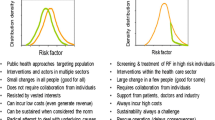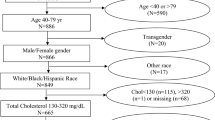Opinion statement
With an aging population, cardiovascular disease (CVD) prevalence will continue to increase for at least the next 30 years. Current clinical trial evidence expands the indications for aggressive treatment of risk factors. Concurrently, the use of new screening and diagnostic technologies will expand the number of identified high-risk individuals requiring clinical care. These likely scenarios will force efficient resource allocation. The impression of the authors is that new models of shared responsibilities of care are needed to enable CVD prevention. All stages of care for those with CVD should entail cooperation among nurses, pharmacists, primary care providers, and cardiovascular specialists in delivering comprehensive, evidence-based care. The persistent treatment gap between current knowledge and clinical practice suggests old models of acute patient care by specialists require revision into fundamentally different systems of long-term care by a team of providers such as that proposed by the Chronic Care Model.
Similar content being viewed by others
References and Recommended Reading
Grundy SM, Cleeman JI, Merz CN, et al.: Implications of recent clinical trials for the National Cholesterol Education Program Adult Treatment Panel III guidelines. Circulation 2004, 110:227–239.
Cannon CP, Braunwald E, McCabe CH, et al.: Intensive versus moderate lipid lowering with statins after acute coronary syndromes. N Engl J Med 2004, 350:1495–1504.
Hennekens CH, Sacks FM, Tonkin A, et al.: Additive benefits of pravastatin and aspirin to decrease risks of cardiovascular disease: randomized and observational comparisons of secondary prevention trials and their meta-analyses. Arch Intern Med 2004, 164:40–44.
Sever PS, Dahlof B, Poulter NR, et al.: Prevention of coronary and stroke events with atorvastatin in hypertensive patients who have average or lower-than-average cholesterol concentrations, in the Anglo-Scandinavian Cardiac Outcomes Trial—Lipid Lowering Arm (ASCOT-LLA): a multicentre randomised controlled trial. Lancet 2003, 361:1149–1158.
Pearson TA, Laurora I, Chu H, Kafonek S: The lipid treatment assessment project (L-TAP): a multicenter survey to evaluate the percentages of dyslipidemic patients receiving lipid-lowering therapy and achieving low-density lipoprotein cholesterol goals. Arch Intern Med 2000, 160:459–467.
Davidson MH, Maki KC, Pearson TA, et al.: Results of the National Cholesterol Education (NCEP) Program Evaluation ProjecT Utilizing Novel E-Technology (NEPTUNE) II survey and implications for treatment under the recent NCEP Writing Group recommendations. Am J Cardiol 2005, 96:556–563.
Swanson JR, Pearson TA: Screening family members at high risk for coronary disease. Why isn’t it done? Am J Prev Med 2001, 20:50–55.
Bodenheimer T, Wagner EH, Grumbach K: Improving primary care for patients with chronic illness. JAMA 2002, 288:1775–1779.
Bodenheimer T, Wagner EH, Grumbach K: Improving primary care for patients with chronic illness: the chronic care model, Part 2. JAMA 2002, 288:1909–1914.
Olivarius NF, Beck-Nielsen H, Andreasen AH, et al.: Randomised controlled trial of structured personal care of type 2 diabetes mellitus. BMJ 2001, 323:970–975.
Mehta RH, Montoye CK, Gallogly M, et al.: Improving quality of care for acute myocardial infarction: the Guidelines Applied in Practice (GAP) Initiative. JAMA 2002, 287:1269–1276.
LaBresh KA, Ellrodt AG, Gliklich R, et al.: Get with the guidelines for cardiovascular secondary prevention: pilot results. Arch Intern Med 2004, 164:203–209.
Pearson TA, Blair SN, Daniels SR, et al.: AHA Guidelines for Primary Prevention of Cardiovascular Disease and Stroke: 2002 Update: Consensus Panel Guide to Comprehensive Risk Reduction for Adult Patients Without Coronary or Other Atherosclerotic Vascular Diseases. American Heart Association Science Advisory and Coordinating Committee. Circulation 2002, 106:388–391.
Snow V, Barry P, Fihn SD, et al.: Evaluation of primary care patients with chronic stable angina: guidelines from the American College of Physicians. Ann Intern Med 2004, 141:57–64.
Snow V, Weiss KB, Mottur-Pilson C; Clinical Efficacy Assessment Subcommittee of the American College of Physicians: The evidence base for tight blood pressure control in the management of type 2 diabetes mellitus. Ann Intern Med 2003, 138:587–592.
Vijan S, Hayward RA; American College of Physicians: Pharmacologic lipid-lowering therapy in type 2 diabetes mellitus: background paper for the American College of Physicians. Ann Intern Med 2004, 140:650–658.
Casalino L, Gillies RR, Shortell SM, et al.: External incentives, information technology, and organized processes to improve health care quality for patients with chronic diseases. JAMA 2003, 289:434–441.
Ornstein S, Jenkins RG, Nietert PJ, et al.: A multimethod quality improvement intervention to improve preventive cardiovascular care: a cluster randomized trial. Ann Intern Med 2004, 141:523–532.
Smith SC Jr: Clinical treatment of dyslipidemia: practice patterns and missed opportunities. Am J Cardiol 2000, 86:62L–65L.
Merz CN, Mensah GA, Fuster V, et al.: Task force #5—the role of cardiovascular specialists as leaders in prevention: from training to champion. 33rd Bethesda Conference. J Am Coll Cardiol 2002, 40:641–651.
Lenfant C: Conquering cardiovascular disease: progress and promise. JAMA 1999, 282:2068–2070.
Ades PA, Balady GJ, Berra K: Transforming exercise-based cardiac rehabilitation programs into secondary prevention centers: a national imperative. J Cardiopulm Rehabil 2001, 21:263–272.
Genest JJ, McNamara JR, Salem DN, Schaefer EJ: Prevalence of risk factors in men with premature coronary artery disease. Am J Cardiol 1991, 67:1185–1189.
Wenger NK, Froelicher ES, Smith LK, et al.: Cardiac rehabilitation as secondary prevention. Agency for Health Care Policy and Research and National Heart, Lung, and Blood Institute. Clin Pract Guidel Quick Ref Guide Clin 1995, Oct(17):1–23.
Haskell WL, Alderman EL, Fair JM, et al.: Effects of intensive multiple risk factor reduction on coronary atherosclerosis and clinical cardiac events in men and women with coronary artery disease. The Stanford Coronary Risk Intervention Project (SCRIP). Circulation 1994, 89:975–990.
Friedman DB, Williams AN, Levine BD: Compliance and efficacy of cardiac rehabilitation and risk factor modification in the medically indigent. Am J Cardiol 1997, 79:281–285.
Cannistra LB, O’Malley CJ, Balady GJ: Comparison of outcome of cardiac rehabilitation in black women and white women. Am J Cardiol 1995, 75:890–893.
Hunt DL, Haynes RB, Hanna SE, Smith K: Effects of computer-based clinical decision support systems on physician performance and patient outcomes: a systematic review. JAMA 1998, 280:1339–1346.
Kaushal R, Shojania KG, Bates DW: Effects of computerized physician order entry and clinical decision support systems on medication safety: a systematic review. Arch Intern Med 2003, 163:1409–1416.
McDonald CJ: Protocol-based computer reminders, the quality of care and the non-perfectability of man. N Engl J Med 1976, 295:1351–1355.
Irvine J, Baker B, Smith J, et al.: Poor adherence to placebo or amiodarone therapy predicts mortality: results from the CAMIAT study. Canadian Amiodarone Myocardial Infarction Arrhythmia Trial. Psychosom Med 1999, 61:566–575.
Litvin CB, Ornstein SM, Anthony WE Jr, Tanner D: Quality improvement using electronic medical records: a case study of a high-performing practice. Top Health Inf Manage 2001, 22:59–64.
Feifer C, Ornstein SM, Nietert PJ, Jenkins RG: System supports for chronic illness care and their relationship to clinical outcomes. Top Health Inf Manage 2001, 22:65–72.
Horwitz RI, Viscoli CM, Berkman L, et al.: Treatment adherence and risk of death after a myocardial infarction. Lancet 1990, 336:542–545.
Influence of adherence to treatment and response of cholesterol on mortality in the coronary drug project [no authors listed]. N Engl J Med 1980, 303:1038–1041.
Levine DM: Behavioral and psychosocial factors, processes, and strategies. In Primer in Preventive Cardiology. Edited by Pearson TA, et al. American Heart Association; Dallas, TX: 1994:217–226.
Berg JS, Dischler J, Wagner DJ, et al.: Medication compliance: a healthcare problem. Ann Pharmacother 1993, 27(9 suppl):S1–S24.
Haynes RB, Sackett DL, Taylor DW, et al.: Manipulation of the therapeutic regimen to improve compliance: conceptions and misconceptions. Clin Pharmacol Ther 1997, 22:125–130.
Greenberg RN: Overview of patient compliance with medication dosing: a literature review. Clin Ther 1984, 6:592–599.
Schedlbauer A, Schroeder K, Peters TJ, Fahey T: Interventions to improve adherence to lipid lowering medication. Cochrane Database Syst Rev 2006, (4):CD004371.
Haynes RB, Yao X, Degani A, et al.: Interventions to enhance medication adherence. Cochrane Database Syst Rev 2005, (4):CD000011.
Pearson TA, Bazzarre TL, Daniels SR, et al.: American Heart Association guide for improving cardiovascular health at the community level: a statement for public health practitioners, healthcare providers, and health policy makers from the American Heart Association Expert Panel on Population and Prevention Science. Circulation 2003, 107:645–651.
Wagner EH, Austin BT, Von Korff M: Organizing care for patients with chronic illness. Milbank Q 1996, 74:511–544.
Smith SC Jr, Jackson R, Pearson TA, et al.: Principles for national and regional guidelines on cardiovascular disease prevention: a scientific statement from the World Heart and Stroke Forum. Circulation 2004, 109:3112–3121.
Smith SC Jr, Allen J, Blair SN, et al.: AHA/ACC guidelines for secondary prevention for patients with coronary and other atherosclerotic vascular disease: 2006 update: endorsed by the National Heart, Lung, and Blood Institute. Circulation 2006, 113:2363–2372.
Mosca L, Banka CL, Benjamin EJ, et al.: Evidence-based guidelines for cardiovascular disease prevention in women: 2007 update. Circulation 2007, 115:1481–1501.
Yancey AK, Robinson RG, Ross RK, et al.: Discovering the full spectrum of cardiovascular disease: Minority Health Summit 2003: report of the Advocacy Writing Group. Circulation 2005, 111:e140–e149.
Grundy SM, Howard B, Smith S Jr, et al.: Prevention Conference VI: Diabetes and Cardiovascular Disease: executive summary: conference proceeding for healthcare professionals from a special writing group of the American Heart Association. Circulation 2002, 105:2231–2239.
Grundy SM, Hansen B, Smith SC Jr, et al.: Clinical management of metabolic syndrome: report of the American Heart Association/National Heart, Lung, and Blood Institute/American Diabetes Association conference on scientific issues related to management. Circulation 2004, 551–556.
Chobanian AV, Bakris GL, Black HR, et al.: Seventh report of the Joint National Committee on Prevention, Detection, Evaluation, and Treatment of High Blood Pressure. Hypertension 2003, 42:1206–1252.
Williams MA, Fleg JL, Ades PA, et al.: Secondary prevention of coronary heart disease in the elderly (with emphasis on patients > or = 75 years of age): an American Heart Association scientific statement from the Council on Clinical Cardiology Subcommittee on Exercise, Cardiac Rehabilitation, and Prevention. Circulation 2002, 105:1735–1743.
Ockene IS, Miller NH: Cigarette smoking, cardiovascular disease, and stroke: a statement for healthcare professionals from the American Heart Association. American Heart Association Task Force on Risk Reduction. Circulation 1997, 96:3243–3247.
Daniels SR, Arnett DK, Eckel RH, et al.: Overweight in children and adolescents: pathophysiology, consequences, prevention, and treatment. Circulation 2005, 111:1999–2012.
Kavey RE, Daniels SR, Lauer RM, et al.: American Heart Association guidelines for primary prevention of atherosclerotic cardiovascular disease beginning in childhood. Circulation 2003, 107:1562–1566.
Author information
Authors and Affiliations
Corresponding author
Rights and permissions
About this article
Cite this article
Block, R.C., Pearson, T.A. Organizing services for cardiovascular prevention. Curr Treat Options Cardio Med 9, 278–286 (2007). https://doi.org/10.1007/s11936-007-0023-4
Published:
Issue Date:
DOI: https://doi.org/10.1007/s11936-007-0023-4




